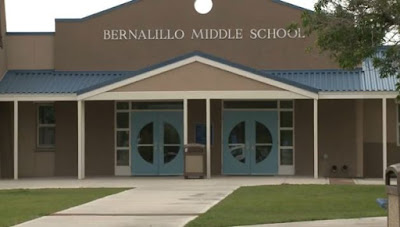MAY 27, 2015
BERNALILLO, N.M. (KRQE)
A middle school science teacher is on paid leave and two
students have been suspended for something that sent two kids to the hospital
according to Bernalillo Public Schools Superintendent Allan Tapia.
Bernalillo Middle School students were one day away from
celebrating the end of the school year.
Sixth grader Ricquie Tarango, 11, said two boys offered her
and another girl candy during class time on Tuesday.
“They put me three drops right here,” Ricquie said pointing
to her hand.
She said she and her friend licked it off their hands.
“It felt like my tongue was going to fall off, and it just
felt horrible,” Ricquie said. “I didn’t know what to do. I was scared.”
The liquid came from an unlabeled bottle.
She said one of the boys told her it was acid, then said he
was just joking.
“Where it was on my hand, it was really yellow,” Ricquie
said. “That is when I started getting scared, and I got a major headache after
that.”
The school called Poison Control and an ambulance took both
girls to the hospital.
Ricquie said the chemical turned out to be copper chloride.
“A [science] teacher from Bernalillo Mid School had asked a
couple of boys, ages 12 and 13, to discard some containers, some boxes,” said
Bernalillo Police Chief Tom Romero. “Apparently in the process, our
understanding is, the two boys took some chemicals from these containers and
kept them.”
“I don’t understand how that teacher could give little
students that poison or whatever for them to dispose of it,” said Oralia
Montoya, Ricquie’s grandma.
Montoya rushed to the hospital on Tuesday after hearing
about the incident.
“Angry, that’s where I was. Angry, very angry about things
happening here at the school,” Montoya said.
Bernalillo Police and the school are investigating.
“I don’t know if this was a prank or what the intent was,
but like the parent, I am disappointed in the entire matter,” Superintendent
Tapia said.
He said the boys deny offering the chemical to the girls.
“I thought those boys were my friends,” Ricquie said. “I
didn’t know they would actually do that to me.”
Ricquie got out of the hospital on Wednesday. She and
her friend are expected to be okay.
Bernalillo Police are forwarding the case to the District
Attorney’s office.
“The District Attorney’s office will review it and make a
determination if there’s any actual criminal intent involved,” Chief Romero
said.
Reports of a similar case came out just last week in Rio
Rancho.
Two Eagle Ridge Middle Schoolers are accused of pouring a
substance into other students’ drinks in a chemistry class.
Those students may face criminal charges.
///----------//
HEALTH HAZARD INFORMATION FOR COPPER CHLORIDE
Effects of Exposure:
Symptoms of acute Cu poisoning include sporadic fever,
tachycardia, hypotension, hemolytic anemia with intravascular hemolysis,
ohguria, coma, cardiovascular collapse and death. Symptoms attributed to
damage of the nervous system and kidneys have been recorded, jaundice has been
observed, and in some cases the liver has been enlarged. Chronic exposure
to copper may damage brain tissue, liver and kidneys. Copper has been
implicated in some forms of cancer, but studies with animals have not yet
proven this link. Symptoms of chronic poisoning include nausea, vomiting,
epigastric pain, yellow watery diarrhea, dizziness, general debility, jaundice,
green saliva, vomitus, and stool.
Chlorine and its compounds are highly irritating to the eyes
and mucous membranes at 3 ppm. Concentrations of about 50 ppm are
dangerous, 1000 ppm may be fatal, even when exposure is short.
Acute and Chronic Effects:
Inhalation: Inhalation may result in coughing,
sneezing, difficulty breathing burning and irritation of the mucous membranes
lining the nose, throat and respiratory tract.
Ingestion: Ingestion of a large amount of Cu may cause
vomiting, gastric pain, dizziness, exhaustion, anemia, cramps, convulsions,
shock, coma, and possibly death. Symptoms attributed to damage to the
nervous system and kidneys have been recorded. Jaundice has been observed
and in some instances the liver has been enlarged.
Skin: May cause itching, irritation and dermatitis on
skin contact. May experience a burning sensation in the exposed area
primarily due to its content of chlorine.
Eye: Copper chloride has been reported as causing
irritation of the conjunctiva, which may be on an allergic basis. May
also cause irritation, redness, burning sensation and watering of the eyes if
it comes in contact.
EMERGENCY AND FIRST AID PROCEDURES:
INHALATION: Remove victim to fresh air, keep warm and
quiet, give oxygen if breathing is difficult and seek medical attention.
INGESTION: Give 1-2 glasses of milk or water and induce
vomiting, seek medical attention. Never induce vomiting or give anything
by mouth to an unconscious person.
SKIN: Remove contaminated clothing, brush material off
skin, wash affected area with mild soap and water. Seek medical attention
if symptoms persist.
EYES: Flush with lukewarm water, lifting upper and
lower eyelids, for at least 15 minutes. Seek medical attention if
symptoms persist.


